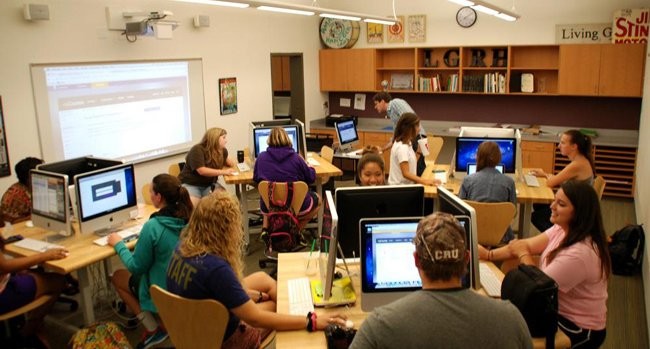10 Ways Design Students Can Better Their Learning
Thanks to advances in technology, there’s more graphic designers out there than ever before. This means the competition will be tougher, and doing just enough to pass your classes doesn’t guarantee anything anymore. It’s important to work towards being the best designer you can be by the time you graduate so you aren’t left behind looking for a job. Here’s a few ways to get the most out of your time in school:
1. Visit nearby design studios
Visiting nearby studios gives you a chance to see how the pros do it in the real world. You may learn some valuable tricks and hear some golden advice while visiting. Make sure to visit studios that do the things you can see yourself doing in the future. ( consider applying for internships as well – if you manage to get one, you’re pretty much guaranteed to really boost your design knowledge ).
2. Use virtual learning sites
Programs like Skillshare and lynda.com can teach more specific skills that aren’t touched on in school or strengthen what you are learning. These are specially great for quickly learning the technical parts of design, such as how to use certain programs and software.
3. Use social media
This may seem like an obvious one, but there are many students I know that don’t take advantage of the social media outlets available. Social media outlets are a great way to increase the amount of eyes that see your work and network with other people. In addition to the popular ones, there are social media outlets made specifically for designers and artists such as Behance and Dribbble. LinkedIn is another important platform students often overlook. Use these outlets to share your work and knowledge, write articles, create videos and any other thing that might help grow your reputation as a designer.
4. Build a custom portfolio
Building a portfolio teaches you how to present and talk about your work. It’s an opportunity to brand yourself and find how you want the world to see you and your work. It will be essential when applying for jobs. Try to make a portfolio that can quickly be updated as work is completed, to allow for continual practice on presentation and to give your viewers something new to look at regularly. Behance and Dribbble can be used as a portfolio, but a custom one looks cooler. It’s okay to put personal and school projects on it, but also try to include some work for real clients, which leads us to our next point: freelancing.
5. Pick up freelance work
Freelancing teaches you valuable lessons that school can’t, such as: how to make agreements with clients, face revision cycles, meet deadlines, write contracts, etc. You deal with real people with real problems, something that you can’t get from school projects alone. Freelancing while in school will get you more prepared for the real world and make you more appealing to potential employers who want to see some experience.
6. Join design student groups and clubs
AIGA student groups help students to grow their skills and knowledge by meeting regularly and talking about design, connecting with nearby professionals, inviting school alumni to share their experiences, reaching out to their local communities, among other things. If there isn’t an AIGA student group at your school, join a group with a similar purpose, or encourage students to form one.
7. Attend design conferences
Attending conferences allows you to meet and learn from some of design’s big names. It’s also a chance to meet students from other schools and create connections. There are several conferences almost everywhere in the country. Some conferences ( like the Austin Initiative for Graphic Awesomeness, for those in Texas ), charge low prices to students.
8. Help other students
Use what you know to help other students when possible. The common phrase “The best way to learn something is to teach it” is pretty much true. This will also help to build relationships with those students and they might be great connections to have in the future.
9. Watch other designers
Watch documentaries, read books, use social media or do whatever you need to stay up to date with the design world and learn from other’s experiences. The internet is a great advantage that current designers have over past designers. Looking up what experienced designers can teach can save you a lot of time and keep you from making whatever mistakes they warn about. It’s also important to see what other young designers and students are doing because they will be the generation of designers that you live your career with ( Remember: Although the design community is often a friendly one, the designers that have the same target audience as you are your competition ).
10. Take real advantage of critiques
Class critiques are an opportunity for students to help each other grow by providing honest, constructive criticism. Unfortunately, many times students are too shy to share their thoughts, or afraid of hurting each other’s feelings, resulting in vague responses like “It looks cool” or, even worse, total silence. Students should provide helpful feedback to their peers and be open to receiving criticism as well. This is the time when students can really help each other grow by sharing thoughts and possibly discovering new solutions.
These tips, when followed, are sure to up your design game to a new level. Stay motivated and help yourself reach your true potential.

